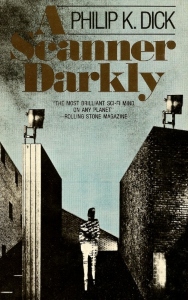My sharpest memory from my first read of “A Scanner Darkly” (1977) was the very Philip K. Dickian scenario of a police detective investigating himself, but not realizing he’s investigating himself. Broadly, it’s a delicious jab at the absurdities that can result when a government agency goes beyond investigating crimes and starts getting into long-term stings where it artificially creates the surrounding reality in order to nab an individual under the law. And indeed, if one wants to read “A Scanner Darkly” as a critique of the War on Drugs, it can play that way.
Crushing tragedy
But my takeaway from this read is the crushing tragedy of people who die or have permanent brain damage from drug use. The book is set in the future of 1994, thus allowing for the high-tech scramble suit that Bob Arctor wears to hide his identity when he’s police detective “Fred,” plus a few other sci-fi touches like holograms and car radios that can covertly record audio. But it feels like it’s set in the 1960s or ’70s. Partly this is because it, like many PKD books, features tech from the time of his writing, notably analog tape recording equipment.
And partly it’s because “A Scanner Darkly” imagines that drug users are more normalized than ever – that drug culture grew in prominence through the decades rather than leveling out. It’s a subgroup, sure, but one that’s noticeable even to the “straights.” Of course, in the real 1994 – and the real 2019 – the War on Drugs continues, doing what it’s arguably designed to do: perpetuate the black-market drug industry. Or, if you’re not that cynical: It’s still failing to curb drug use.

“A Scanner Darkly” (1977)
Author: Philip K. Dick
Genre: Science fiction
Setting: Bay Area, future 1994
It might simply be because this book is entirely about drug users and drug warriors, but those groups are mainstreamed under PKD’s keystrokes – even though the culture is weird and tangled. PKD nicely outlines the situation on page 87, where Bob Arctor ruminates on how the line has become blurred between drug users and narcotics agents:
Several narcotics agents that he had known had posed as dealers in their undercover work and wound up selling (drugs). This was a good cover, but it also brought the nark a gradually increasing profit over and above his official salary. … (A)fter a time some of them began to phase out their law-enforcement activities in favor of full-time dealing. But then, too, certain dealers, to burn their enemies or when expecting imminent busts, began narking and went that route, winding up as sort of unofficial undercover narks. It all got murky.
Arctor’s mind is likewise murky, as Substance D chemically separates the two halves of his brain (a phenomenon the author draws from real scientific studies). This is how he can be investigating himself – watching recorded tapes of himself and his roommates from the police department’s nearby safehouse – while thinking it’s a different person. Mostly writing from Bob’s/Fred’s point of view, PKD does a wonderful job of illustrating the gradual deterioration of a drug-destroyed mind.

Room for humor … darkly
A lot of “A Scanner Darkly” is funny, even in simple scenes of Bob and his roommates shooting the breeze while hanging out and doing various drugs. Sometimes the humor comes from Bob’s paranoia, like when he imagines various horrible consequences from a break-in of his house only to realize it’s merely his girlfriend, Donna, who came over. She’s been sleeping in the other room while he works himself into a panic.
However, tragedy is the prevailing tone. PKD starts the book with a chapter about Jerry, who believes aphids are everywhere. The novel concludes with Bob struggling to learn how to clean bathrooms at New-Path, a facility for drug addicts.
The author’s note at the end is devastating, as PKD dedicates the novel to a long list of friends who died or had their brains destroyed (a fate worse than death, as we see in the story). PKD notes that there’s no moral to “A Scanner Darkly,” and that’s my impression of it.
He’s not saying Bob and his friends are innocents who got tricked into starting to use drugs. They knew it was dangerous. But no one knew it was this dangerous. Additionally, the story shows how the government perpetuates the cycle and possibly even launched Substance D as a cash crop. It’s hard to argue with PKD’s overarching point: “(These) people were punished entirely too much for what they did.”
“A Scanner Darkly” is both anti-drug and anti-drug-war, but those messages are subsumed by the tragedy that befalls Bob and his friends. The book’s tense detective portion has a resolution, but it’s beside the point as we switch over to wallowing in a horror show. Meanwhile, the futuristic elements are never anything more than tools to tell the story. Rather than a weakness, PKD’s shift away from genre toward the stark toll for Bob Arctor makes “A Scanner Darkly” one of the most powerful novels about the drug experimentation era.

